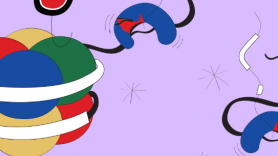1. Epigenetics: from knowledge to applications
Although it is not always obvious, there is an intimate connection between the most basic research (that geared towards researching the most intimate mechanisms of cells) and applied research (which seeks more tangible, practical uses and, in the vast majority of cases, couldn’t exist without the former). One example of this relationship emerged in the presentation given by Manel Esteller, director of the Cancer Epigenetics and Biology Program (PEBC) at IDIBELL Barcelona.
“Epigenetics is responsible for different types of tissue developing from stem cells, and even for some cells returning to stem cells,” explained Esteller. But this basic function, in health, can be altered. It is so closely tied to cell division that changes in how it is regulated are part of nearly all tumor processes. “One of our lab’s main goals is to have the results of our research help improve how cancer patients are managed,” he said. His team has worked on a wide array of lines of research, all touching on various areas of epigenetics, in particular those associated with DNA methylation.
In general terms, there are three types of epigenetic mechanisms: DNA methylation, histone modifications and non-coding RNA, all of which interact and play amongst themselves. The first is when methyl groups are added to the DNA molecule, which tends to compact it and make it harder to read, inhibiting gene expression. Histones are the proteins that DNA coils around and, depending on the chemical markers added, they can also make it more compact or open, block or allow entry and reading. Non-coding RNA are truncated messengers. While RNA is the mediator between DNA and its final product, proteins, this type in particular does not create any proteins, it normally impedes others from doing so. It is, once again, an inhibiting agent.
“One of the fundamental pillars of cancer epigenetics,” explained Esteller, “is that it can inhibit tumor-suppressor genes, generally through methylation gain. They are genes that aren’t mutated, but hyper-methylated.” Some of them can also condition treatment, like the MGMT gene, whose methylation is associated with the success of chemotherapy in gliomas, a type of brain tumor. “We’ve also seen that methylation of the SLFN11 gene is associated with sensitivity to platinum-based therapies, which could be a step forward in personalized medicine,” Esteller commented.
This type of methylation tends to occur in the vicinity of some genes, those called promoters, acting as a sort of lock that allows or impedes entry and reading. But it is much more complex than this. “We’ve seen that it can also happen in the enhancers.” These switches or enhancers are located far from the genes, but DNA has a 3D structure and, due to its spatial make-up, they can get in there and have a direct influence on expression. “We’ve seen that a gene associated with Fanconi anemia and DNA repair (and therefore with many tumors) can be altered by the methylation of an enhancer,” explained Esteller. “That’s why we hadn’t seen it in all these years.”
One of the applications of DNA methylation already available in clinical practice is classifying cancer of unknown primary site. In 5% of patients, “physicians detect cancer that has already metastasized but can’t find the primary origin.” The prognosis in these cases is very bad, because there are not any clues as to the most effective treatment. In Esteller’s lab, they have been able to identify origin based on methylation profiles quite precisely. Although they are still very serious cases, the tool improves life expectancy and has already been approved for clinical use.
These are some examples of applications from research. But many aspects of the most basic, intimate mechanisms of epigenetics are still not understood. A large part of the advances presented were associated with genome architecture and another key pillar: histones.



